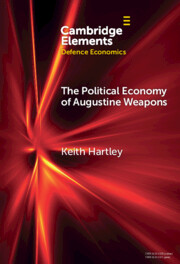Refine search
Actions for selected content:
124 results
Is French an “evidential language”? A reassessment of the evidential uses of French tenses
-
- Journal:
- Journal of French Language Studies / Volume 35 / 2025
- Published online by Cambridge University Press:
- 19 November 2025, e20
-
- Article
-
- You have access
- Open access
- HTML
- Export citation

The Political Economy of Augustine Weapons
-
- Published online:
- 30 October 2025
- Print publication:
- 27 November 2025
-
- Element
- Export citation
Chapter 14 - W. B. Yeats, Alice Milligan, and Revivalist Heroism
- from Part IV - Revivalist Futures
-
-
- Book:
- The Revival in Irish Literature and Culture
- Published online:
- 04 September 2025
- Print publication:
- 18 September 2025, pp 281-302
-
- Chapter
- Export citation
Postscript
-
- Book:
- Weaponizing Language
- Published online:
- 27 November 2025
- Print publication:
- 28 August 2025, pp 181-186
-
- Chapter
- Export citation
11 - Conclusion
-
- Book:
- Appearance, Disability and the Law
- Published online:
- 31 July 2025
- Print publication:
- 14 August 2025, pp 178-183
-
- Chapter
- Export citation
9 - Adolf Reinach and Gerhart Husserl on the Foundations of Legal Phenomenology and the Temporality of Law
- from Part III - Reinach and Legal Concepts
-
-
- Book:
- Reinach and the Foundations of Private Law
- Published online:
- 20 July 2025
- Print publication:
- 07 August 2025, pp 219-253
-
- Chapter
-
- You have access
- Open access
- HTML
- Export citation
Rupturing the Temporality of Pharmaceutical Patents: A Sketch for a New Temporal Economy of Pharmaceutical Markets
-
- Journal:
- Journal of Law, Medicine & Ethics / Volume 53 / Issue 3 / Fall 2025
- Published online by Cambridge University Press:
- 18 July 2025, pp. 337-344
- Print publication:
- Fall 2025
-
- Article
-
- You have access
- Open access
- HTML
- Export citation
Chapter 4 - Beyond
-
- Book:
- Embodiment in Nineteenth-Century American Literature
- Published online:
- 29 June 2025
- Print publication:
- 17 July 2025, pp 126-149
-
- Chapter
- Export citation
The Fictitious Shine of Japan’s Future
-
- Journal:
- Asia-Pacific Journal / Volume 23 / 2025
- Published online by Cambridge University Press:
- 10 June 2025, e8
-
- Article
-
- You have access
- Open access
- HTML
- Export citation
1 - The Challenge Ahead
-
- Book:
- A Climate of Truth
- Published online:
- 27 March 2025
- Print publication:
- 27 March 2025, pp 14-20
-
- Chapter
- Export citation
2 - Standing Further Back
-
- Book:
- A Climate of Truth
- Published online:
- 27 March 2025
- Print publication:
- 27 March 2025, pp 21-36
-
- Chapter
- Export citation
Introduction
-
- Book:
- A Climate of Truth
- Published online:
- 27 March 2025
- Print publication:
- 27 March 2025, pp 1-13
-
- Chapter
- Export citation
Chapter 24 - A Look Ahead for Prediction Research
- from Part V - The Future of Prediction
-
- Book:
- Looking Ahead
- Published online:
- 20 March 2025
- Print publication:
- 06 March 2025, pp 278-291
-
- Chapter
- Export citation
The Future of Strikes and Trade Unions
-
- Journal:
- International Labor and Working-Class History / Volume 106 / October 2024
- Published online by Cambridge University Press:
- 14 November 2024, pp. 426-438
-
- Article
-
- You have access
- Open access
- HTML
- Export citation
Securing the Future of the Humanities
- Part of
-
- Journal:
- Public Humanities / Volume 1 / 2025
- Published online by Cambridge University Press:
- 04 November 2024, e11
-
- Article
-
- You have access
- Open access
- HTML
- Export citation
Chapter 31 - The Future of Dictionaries
- from Part VI - The Future of Dictionaries
-
-
- Book:
- The Cambridge Handbook of the Dictionary
- Published online:
- 19 October 2024
- Print publication:
- 31 October 2024, pp 651-667
-
- Chapter
- Export citation
Entrepreneurial Imaginaries: Finding the Fortune in Futures
-
- Journal:
- Enterprise & Society / Volume 25 / Issue 3 / September 2024
- Published online by Cambridge University Press:
- 25 October 2024, pp. 643-668
- Print publication:
- September 2024
-
- Article
-
- You have access
- Open access
- HTML
- Export citation
15 - Conclusion
-
- Book:
- How Government Built America
- Published online:
- 08 May 2024
- Print publication:
- 09 May 2024, pp 176-182
-
- Chapter
- Export citation
The future is just another past
-
- Journal:
- Review of International Studies / Volume 50 / Issue 3 / May 2024
- Published online by Cambridge University Press:
- 06 May 2024, pp. 425-440
- Print publication:
- May 2024
-
- Article
-
- You have access
- Open access
- HTML
- Export citation
On the horizon: The futures of IR
-
- Journal:
- Review of International Studies / Volume 50 / Issue 3 / May 2024
- Published online by Cambridge University Press:
- 06 May 2024, pp. 415-424
- Print publication:
- May 2024
-
- Article
-
- You have access
- HTML
- Export citation
